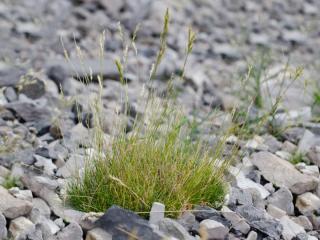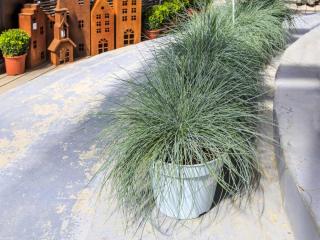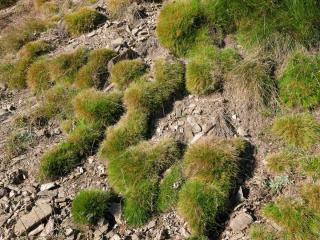

In spring, spiky fescue has an acidic green color that matures to emerald green.
Key spiky fescue facts
Name: Festuca gautieri (syn. F. scopari)
Common: spiky fescue, bearskin fescue
Type: perennial grass
Height: 15 cm
Exposure: full sun, partial shade
Soil: well-drained, dry, poor
Foliage: evergreen – Flowering: end of spring
This little perennial grass forms a dense, round cushion with evergreen foliage. Resistant to both drought and frost, this fescue is perfect for filling rock gardens, slopes, and even the foreground of flower beds or borders. Spiky fescue is an excellent ground cover plant that thrives in the most challenging soils.
This smallish fescue, sometimes called Gautier’s fescue, can be planted either in autumn or spring.

As for the soil, the poorer, the better! In fact, this little fescue looks its best in a dry, rocky, or sandy soil that is not overly chalky. So not ideal for limestone. However, it must be well-drained as excess moisture can hinder its growth.
Given these growing conditions, this fescue can easily find its place in a rock garden or on a slope with poor soil, as well as along a border. Whether planted individually or “en masse” with 5 to 7 plants per square meter to cover the ground, the dense tuft of leaves is a definite eye-catcher.

Spiky fescue can be planted anywhere in temperate climates, as it can withstand drying winds and salt spray. The key is to ensure the soil is well-drained.
Spiky fescue is perfect for low-maintenance, dry gardens. It doesn’t require much attention:
Undoubtedly, among the large family of fescues, this variety is full of charm and deserves a place in any garden:
 Its evergreen foliage decorates flower beds, rockeries, and slopes throughout the year.
Its evergreen foliage decorates flower beds, rockeries, and slopes throughout the year.With its vibrant green foliage, spiky fescue looks great alongside blue fescue (Festuca glauca) and light gray fescue (Festuca mairei) to create a unique yet aesthetic contrast.
Persistent foliage brings lightness to flowerbeds and rock gardens, whether in a Mediterranean garden or a contemporary garden with clean lines, in the company of baby’s breath, or other frugal plants like lavenders, cotton lavenders, and agastaches.
Bearskin fescue also finds its place at the base of roses or peonies, or surrounded by flowering perennials such as echinaceas and helenium. Its vibrant green color pairs well with the green of rosemary and lemon thyme on light gravel. You could also associate it with agave.
Also, consider planting spring bulbs nearby: they’ll sprout between clumps with elegance.